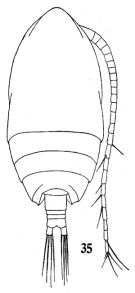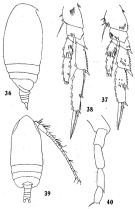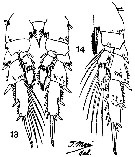|
|
 |
Fiche d'espèce de Copépode |
|
|
Calanoida ( Ordre ) |
|
|
|
Calanoidea ( Superfamille ) |
|
|
|
Paracalanidae ( Famille ) |
|
|
|
Acrocalanus ( Genre ) |
|
|
| |
Acrocalanus monachus Giesbrecht, 1888 (F,M) | |
| | | | | | | Ref.: | | | Giesbrecht, 1892 (p.171, 175, 770, figs.F); Giesbrecht & Schmeil, 1898 (p.25, Rem. F); Thompson & Scott, 1903 (p.233, 243); Wolfenden, 1905 (1906) (p.1002, figs.); A. Scott, 1909 (p.30, Rem.); Sewell, 1912 (p.353, 359); 1929 (p.83); Farran, 1936 a (p.81); Mori, 1937 (1964) (p.32, figs.F); Sewell, 1947 (p.53); C.B. Wilson, 1950 (p.158, fig.F); Grice, 1962 (p.187, figs.F, Rem.); Kasturirangan, 1963 (p.24, fig.F); Chen & Zhang, 1974 (p.106, figs.F,M); Greenwood, 1976 (p.19); Zheng & al., 1982 (p.29, figs.F); Hiromi, 1987 (p.154); Bradford-Grieve, 1994 (p.51, figs.F); Chihara & Murano, 1997 (p.846, Pl.136: F,M); Bradford-Grieve, 1999 (p.877, 909, figs.F); Conway & al., 2003 (p.156, figs.F,M, Rem.); Phukham, 2008 (p.118, figs.F) |  issued from : Q.-c. Chen & S.-c. Zhang in Studia Marina Sinica, 1974, 9. [Pl.3, Fig.35]. Female (from South China Sea): 35, habitus (dorsal).
|
 issued from : Q.-c. Chen & S.-z. Zhang in Studia Marina Sinica, 1974, 9. [Pl.4, Fig.36-40]. Female: 36, habitus (lateral right side); 37, P3; 38, P4. Male: 39, habitus (dorsal); 40, P5.
|
 issued from : T. Mori in The pelagic Copepoda from the neighbouring waters of Japan, 1937 (1964). [Pl.12, Fig.10]. Female: 10, habitus (lateral).
|
 issued from : T. Mori inThe pelagic Copepoda from the neighbouring waters of Japan, 1937 (1964). [Pl.13, Figs.13-14]. Female: 13, P2 (posterior); 14, P3 (posterior).
|
 issued from : Z. Zheng, S. Li, S.J. Li & B. Chen inMarine planktonic copepods in Chinese waers. Shanghai Sc. Techn. Press, 1982 [p.29, Fig.16]. Female: a-b, habitus (dorsal and lateral, respectively); c, P3; d, P4. Scale bars in mm.
|
 issued from : G.D. Grice in Fish. Bull. Fish and Wildl. Ser., 1962, 61. [p.186, Pl.6, Figs.7-9]. Female (from equatorial Pacific): 7-8, habitus (dorsal and lateral, respectively); 9, P4 (posterior). Nota: The truncate appearance of this species in lateral view distinguishes it from others in the genus.
|
 Issued from : W. Giesbrecht in Systematik und Faunistik der Pelagischen Copepoden des Golfes von Neapel und der angrenzenden Meeres-Abschnitte. - Fauna Flora Golf. Neapel, 1892, 19 , Atlas von 54 Tafeln. [Taf. 10, 38]. Female: exopodite of P4.
|
 Issued from : W. Giesbrecht in Systematik und Faunistik der Pelagischen Copepoden des Golfes von Neapel und der angrenzenden Meeres-Abschnitte. – Fauna Flora Golf. Neapel, 1892, 19 , Atlas von 54 Tafeln. [Taf. 6, Figs.26, 31. Female: 26, habitus (lateral); 31, same (dorsal).
|
 issued from : N. Phukham in Species diversity of calanoid copepods in Thai waters, Andaman Sea (Master of Science, Univ. Bangkok). 2008. [p.201, Fig.75]. Female (from W Malay Peninsula): a-b, habitus (dorsal and lateral, respectively); c, P4. Body length after the drawing: F = 0.849 mm (urosome probably curved).
| | | | | Ref. compl.: | | | Wilson, 1942 a (p.170); Sewell, 1948 (p.391, 395, 407, 412, 433, 437); Krishnaswamy, 1953 (p.115); Chiba & al., 1957 (p.306); 1957 a (p.11); Ganapati & Shanthakumari, 1962 (p.7, 15); Fagetti, 1962 (p.14); De Decker, 1964 (p.14, 17, 27); De Decker & Mombeck, 1964 (p.11); Grice & Hulsemann, 1967 (p.14); Fleminger, 1967 a (tabl.1); Vinogradov, 1968 (1970) (p.78); Timonin, 1971 (p.281, trophic group); Heinrich, 1973 (p.95); Carter, 1977 (1978) (p.35); Dessier, 1983 (p.89, Tableau 1, Rem., %); Guangshan & Honglin, 1984 (p.118, tab.); De Decker, 1984 (p.315, 329: chart); Binet, 1984 (tab.3); Brinton & al., 1986 (p.228, Table 1); Madhupratap & Haridas, 1986 (p.105, tab.1); Dessier, 1988 (tabl.1); Hernandez-Trujillo, 1989 a (tab.1); Mitra & al., 1990 (fig.3); Yoo, 1991 (tab.1); Hernandez-Trujillo, 1991 (1993) (tab.I); Shih & Young, 1995 (p.71); Suarez-Morales & Gasca, 1998 a (p.110); Wong & al, 1998 (tab.2); Noda & al., 1998 (p.55, Table 3, occurrence); Lavaniegos & Gonzalez-Navarro, 1999 (p.239, Appx.1); Lo & al., 2001 (1139, tab.I); Dalal & Goswami, 2001 (p.22, fig.2); Uysal & al., 2002 (p.17, tab.1); Hwang & al., 2003 (p.193, tab.2); Shimode & Shirayama, 2004 (tab.2); Hsiao & al., 2004 (p.326, tab.1); Rezai & al., 2004 (p.489, tab.2); Chang & Fang, 2004 (p.456, tab.1); Lan & al., 2004 (p.332, tab.1, tab.2); Lo & al. *, 2004 (p.218, tab.1, fig.6); Gallienne & al., 2004 (p.5, tab.3); Lo & al., 2004 (p.89, tab.1); Kazmi, 2004 (p.230); Hwang & al., 2006 (p.943, tabl. I); Prusova & Smith, 2005 (p.75); Hwang & al., 2007 (p.24); Dur & al., 2007 (p.197, Table IV); Jitlang & al., 2008 (p.65, Table 1); McKinnon & al., 2008 (p.844: Tab.1); Selifonova & al., 2008 (p.305, Tabl. 2); Ayon & al., 2008 (p.238, Table 4: Peruvian samples); Fernandes, 2008 (p.465, Tabl.2); Lan Y.C. & al., 2008 (p.61, Table 1, % vs stations); Tseng L.-C. & al., 2008 (p.153, Table 2, fig.5, occurrence vs geographic distribution, indicator species); Tseng & al., 2008 (p.402, Table 2); C.-Y. Lee & al., 2009 (p.151, Tab.2); Tseng & al., 2009 (p.327, fig.5, feeding); Lan Y.-C. & al., 2009 (p.1, Table 2, % vs hydrogaphic conditions); Hernandez-Trujillo & al., 2010 (p.913, Table 2); Cornils & al., 2010 (p.2076, Table 3); Fazeli & al., 2010 (p.153, Table 1,as monochus); Schnack-Schiel & al., 2010 (p.2064, Table 2: E Atlantic subtropical/tropical); W.-B. Chang & al., 2010 (p.735, Table 2, abundance); Hsiao S.H. & al., 2011 (p.475, Appendix I); Hsiao & al., 2011 (p.317, Table 2, indicator of seasonal change); Kâ & Hwang, 2011 (p.155, Table 3: occurrence %); Tseng L.-C. & al., 2011 (p.47, Table 2, occurrences vs mesh sizes); Selifonova, 2011 a (p.77, Table 1, alien species in Black Sea); Tutasi & al., 2011 (p.791, Table 2, abundance distribution vs La Niña event); Jang M.-C & al., 2012 (p.37, abundance and seasonal distribution); Tseng & al., 2012 (p.621, Table 3: abundance); Cornils & Blanco-Bercial, 2013 (p.861, Table 1, molecular analysis, figs.3, 4, 5); in CalCOFI regional list (MDO, Nov. 2013; M. Ohman, pers. comm.); Tseng & al., 2013 (p.507, seasonal abundance); Jagadeesan & al., 2013 (p.27, Table 3, seasonal abundance); Hwang & al., 2014 (p.43, Appendix A: seasonal abundance); Jerez-Guerrero & al., 2017 (p.1046, Table 1: temporal occurrence); Palomares-Garcia & al., 2018 (p.178, Table 1: occurrence) | | | | NZ: | 14 | | |
|
Carte de distribution de Acrocalanus monachus par zones géographiques
|
| | | | | | | | | | | | | Loc: | | | South Africa (E & W), Medit. (NW Lebanon Basin) (in Uysal & al., 2002), W Black Sea, Red Sea, Gulf of Oman, Arabian Sea, Maldives Is., Madagascar, Rodrigues Is. - Seychelles, Mascarene Basin, G. of Mannar, Palk Bay, Sri Lanka (Pearl Banks), Natal, Indian, India (W, Madras, Lawson's Bay, Mandarmani), G. of Bengal, S Burma, W Malay Peninsula (Andaman Sea), Straits of Malacca, Indonesia-Malaysia, SW Celebes, Philippines, Viet-Nam (Cauda Bay), China Seas (Yellow Sea, East China Sea, South China Sea), Taiwan Strait, Taiwan (S, E, SW, Kaohsiung Harbor, NW, N, Mienhua Canyon, NE), Korea Strait, Japan, Kuchinoerabu Is., Hokkaido, off SE Japan, Bikini, Pacif. (equatorial), Australia (Great Barrier, Moreton Bay, Shark Bay, North West Cape), New Caledonia, Fidji Is., N Marquises Is., Hawaii, California, Baja California (Bahia Magdalena, La Paz), G of California, Tahiti, off NE Tuamotu, Bahia Cupica (Colombia), Galapagos-Ecuador, off Peru, Chile
Data from Cornils & Blanco-Bercial (2013): 17°11'S; 150°25'W. | | | | N: | 110 | | | | Lg.: | | | (34) F: 0,96-0,92; (47) F: 0,92; (91) F: 1-0,9; (101) F: 1,1-1; (338) F: 1,03-0,88; M: 0,88-0,79; (786) F: 1,08-0,99; (795) F: 0,92-0,91; (991) F: 0,9-1,1; (1023) F: 1,01; (1047) F: 0,90; {F: 0,88-1,10; M: 0,79-0,88} | | | | Rem.: | La présence de cette espèce dans le Bassin Levantin (signalée à ma connaissance, pour la première fois par Uysal & al., 2002) pourrait avoir été introduite à partir de la mer Rouge (Lessepsian migration).
Voir aussi les remarques en anglais | | | Dernière mise à jour : 16/12/2021 | |
|
|
 Toute utilisation de ce site pour une publication sera mentionnée avec la référence suivante : Toute utilisation de ce site pour une publication sera mentionnée avec la référence suivante :
Razouls C., Desreumaux N., Kouwenberg J. et de Bovée F., 2005-2025. - Biodiversité des Copépodes planctoniques marins (morphologie, répartition géographique et données biologiques). Sorbonne Université, CNRS. Disponible sur http://copepodes.obs-banyuls.fr [Accédé le 16 août 2025] © copyright 2005-2025 Sorbonne Université, CNRS
|
|
 |
 |












